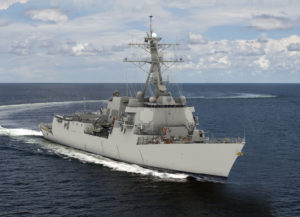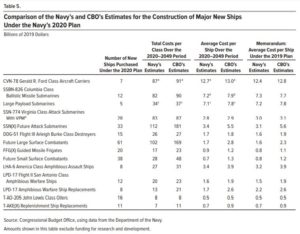The Congressional Budget Office’s (CBO) annual analysis of the Navy’s 30-year shipbuilding plan argues the next Large Surface Combatant (LSC) ship may cost $67 billion more than the Navy is planning.
The Navy plans to develop and purchase a new LSC to succeed Arleigh Burke-class DDG-51 Flight I and Flight II ships when they retire from the late 2020s to 2030s. The Navy’s fiscal year 2020 30-year plan expects production of the LSC to start in 2025, five years sooner than under the FY 2019 plan, and it will buy 61 ships through 2049.

The service estimates each LSC will cost an average of $1.7 billion per hull, which the Government Accountability Office noted is the same estimated price for the DDG-51 Flight III ship and $400 million less than the Navy’s LSC estimate in the 2017 plan.
In contrast, CBO projects the LSC will cost an average of $2.8 billion, about 65 percent more than the Navy projects.
“Over the 2020–2049 period, CBO estimates, the Navy would need $169 billion in funding for the future LSC portion of the shipbuilding program—$67 billion more than the Navy’s $102 billion estimate.”
The CBO’s estimates are larger than its FY 2019 report. Last year CBO estimated the LSC would cost about $2.3 billion on average per vessel, 30 percent higher than the Navy’s $1.6 billion estimate. The report estimated the ships would cost $34 billion more in total than the Navy estimated (Defense Daily, Oct. 19, 2018).
“That estimate implies that the new LSC would be either a destroyer-sized ship with capabilities that represent only a modest improvement over the DDG-51 Flight III or a smaller ship with significantly improved capabilities based on new design technologies,” the report said.
However, the Navy has previously said while LSC will have capabilities equivalent to a DDG-51 Flight III, it will have a larger hull, more power, stealthier characteristics, and a larger capacity for new weapons and future capabilities.
In June, Rear Adm. William Galinis, Program Executive Officer for Ships, confirmed these characteristics but said “I think in the end, you know, it’s probably going to look a lot more like a DDG-1000 than a DDG-51 if I had so say so” (Defense Daily, June 20).
Similarly, last year then-Rear Adm. Ron Boxall, Director of Surface Warfare, said the service was at the limit of what it could do with the DDG-51 hull and may take the DDG-1000 integrated power system.
“We want to take the capability that we like in the DDG Flight III and move it over to a new and larger hull so it’s got room and opportunity for growth,” Boxall said in 2018 (Defense Daily, Oct. 29, 2018).
In March, Boxall used the example of the issues the Navy is balancing on how to install the Lockheed Martin [LMT] High Energy Laser and Integrated Optical-dazzler with Surveillance (HELIOS) 60-150 kW directed energy (DE) system on DDG-51 ships helps explain the service’s approach with LSCs for a great power generating capacity and bigger hull (Defense Daily, March 20).
This power management “drives us to why one of the main reasons we need a new large surface combatant is that margin for power weapons, energy weapons, higher power radars, electronic warfare systems, and all of the things we need for more and more power.”
These statement imply a possible clash in cost estimates with what Secretary of the Navy Richard Spencer and former Chief of Naval Operations Adm. John Richardson told Congress earlier this year (Defense Daily, May 2).
Spencer told the Senate Appropriations Defense Subcommittee that given what the service has learned from industrial cooperation on the new guided-missile frigate, FFG(X), he believes that will transition to the LSC. He also said that will take into account the health of the industrial base.
Richardson agreed that the Navy is working to “bring industry into the discussion of the requirements. So that we’re not coming off with something that will just be impossible to invent and then build and then integrate.”
He compared it to the Navy’s work with industry on requirements for the FFG(X) and MQ-25 unmanned carrier tanker aircraft.
CBO said the Navy’s LSC cost estimate suggests it will be based on a modified version of the DDG-51 Flight III ship. In contrast, given these kinds of statements, CBO estimates the LSC will have a largely new design and would displace 12,000 tons, 2,000 tons more than the Flight III.
The office noted this is a “substantial change” in its estimate for the size of ships compared to the 2019 plan, when it estimated a 10,000-ton displacement.
“CBO’s change is based in part on statements by senior Navy leaders about the features they expect the new surface combatant to have. A newly designed ship would be more expensive to build than a modified version of an existing ship.”
The report said comments like Boxall’s “appear to validate CBO’s assumption.”

GAO warned that “the great uncertainty about the ultimate size and capabilities of the future class of LSCs suggests that the true cost could differ substantially from both the Navy’s and CBO’s estimates.”
The Navy’s FY 2020 budget request laid out a plan to buy the first LSC no earlier than 2025, pushing back the ship from earlier statements by officials that the service hoped to have an LSC on contract by the early to mid-2020s. The Navy expects to release a final request for proposals by 2024 (Defense Daily, March 19).
In February, the Navy issued two requests for information (RFIs) for the Large Surface Combatant to gather industry insight and market research to support requirements development and design efforts (Defense Daily, Feb. 26).
The new CBO report largely repeats its analysis of the FY 2019 shipbuilding plan, which found the Navy’s plan to increase shipbuilding to reach a 355-ship fleet would cost a third more than the service estimates, or $660 billion versus $865 billion.
The FY 2020 analysis says this difference in LSC estimates accounts for about a third of the total difference.
CBO’s estimates are higher, it says, “because CBO and the Navy made different assumptions about the design and capabilities of some future ships, used different estimating methods, and treated growth in shipbuilding labor and materials costs differently.”
Most of the differences are on “uncertainty about the design and capabilities of large ships whose construction would begin in 5 or 10 years,” the latest report says.
CBO says the difference in shipbuilding estimates widens over time partially because the Navy’s method for developing constant-dollar estimates does not account for the faster growth in costs of labor and materials in the shipbuilding industry than in the economy overall.
“The Navy’s estimate does not reflect the increase in the real (inflation-adjusted) costs of ships with today’s capabilities that CBO anticipates in future purchases of such ships,” CBO says.
Beyond LSC, another third of the difference between the estimates revolves around uncertainty in the planned post-Virginia-class attack submarine, SSN(X). The Navy estimates building 33 SSN(X) vessels from 2031-2049 at a cost of $112 billion, or $3.4 billion per hull.
CBO estimates the cost for the submarines at $181 billion or about $5.5 billion per hull. This is a $69 billion total difference between the estimates. This is similar to CBO’s FY 2019 analysis.
The Navy’s plan envisions a vessel more capable than the Virginia-class but without the Block V’s Virginia Payload Module. It plans for the new submarine to be stealthier, faster, and carry more torpedoes than the Virginia-class. CBO estimates this as similar to the Seawolf-class, assuming a submarine of that size, displacing 9,100 tons and having a new design.
“The large difference between the Navy’s and CBO’s estimates under the 2020 plan suggests either that the Navy’s cost estimates may be optimistic in light of the SSN(X)’s proposed capabilities or that the two estimates relied on widely different assumptions about the submarine’s size, capabilities, and design. As a result, the SSN(X)’s final capabilities and costs are highly uncertain,” CBO says.